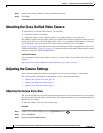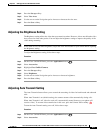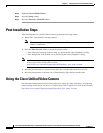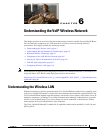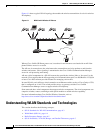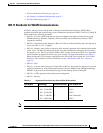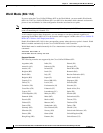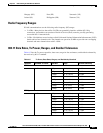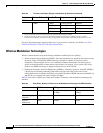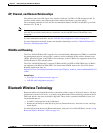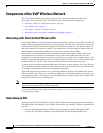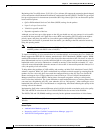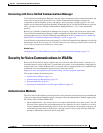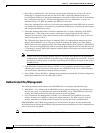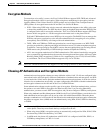
6-6
Cisco Unified IP Phone 8961, 9951, and 9971 Administration Guide for Cisco Unified Communications Manager 8.5 (SIP)
OL-20861-01
Chapter 6 Understanding the VoIP Wireless Network
Understanding WLAN Standards and Technologies
Wireless Modulation Technologies
Wireless communications uses the following modulation technologies for signaling:
• Direct-Sequence Spread Spectrum (DSSS)—Prevents interference by spreading the signal over the
frequency range or bandwidth. DSSS technology multiplexes chunks of data over several
frequencies so that multiple devices can communicate without interference. Each device has a
special code that identifies its data packets and all others are ignored. Cisco wireless 802.11b/g
products use DSSS technology to support multiple devices on the WLAN.
• Orthogonal Frequency Division Multiplexing (OFDM)—Transmits signals by using RF. OFDM is
a physical-layer encoding technology that breaks one high-speed data carrier into several
lower-speed carriers to transmit in parallel across the RF spectrum. OFDM, when used with 802.11g
and 802.11a, can support data rates as high as 54
Mbps.
Table 6-3 provides a comparison of data rates, number of channels, and modulation technologies by
standard.
802.11b
17 dBm 1 Mbps 1,010 ft (308 m) -96 dBm
2 Mbps 951 ft (290 m) -85 dBm
5.5 Mbps 919 ft (280 m) -90 dBm
11 Mbps 902 ft (275 m) -87 dBm
1. Adjusts dynamically when associating with an AP if the AP client setting is enabled.
2. Advertised rates by the APs are used. If the Restricted Data Rates functionality is enabled in the Cisco Unified
Communications Manager Administration phone configuration, then the Traffic Stream Rate Set IE (CCX V4) is used.
For more information about supported data rates, tx power and rx sensitivity for WLANs, see Cisco
Unified IP Phone 9971 Wireless LAN Deployment Guide.
Table 6-2 Tx Power, Data Rates, Ranges, and Decibels by Standard (continued)
Standard Maximum Tx Power
1
Data Rate
2
Range Receiver Sensitivity
Table 6-3 Data Rates, Number of Channels, and Modulation Technologies by IEEE Standard
Item 802.11b 802.11g 802.11a
Data Rates 1, 2, 5.5, 11 Mbps 6, 9, 12, 18, 24, 36, 48,
54 Mbps
6, 9, 12, 18, 24, 36, 48,
54 Mbps
Non-overlapping
Channels
3 (Japan uses 4) 3 Up to 23
Wireless
Modulation
DSSS OFDM OFDM



